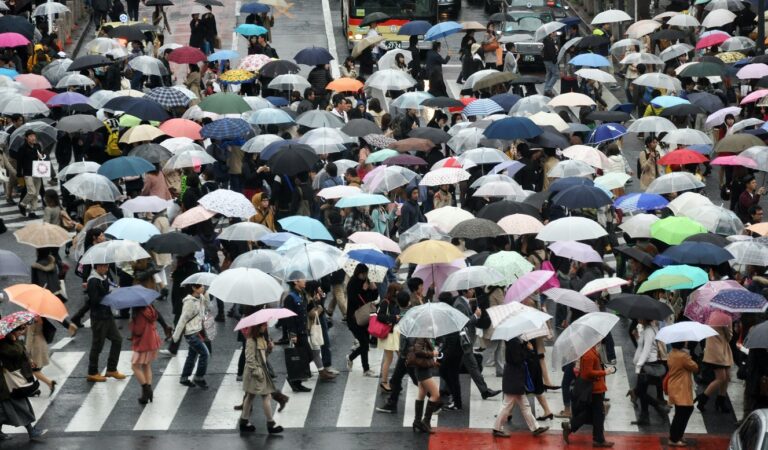The only natural process that leads to the accumulation of freshwater on Earth is precipitation. As a result, it is essential for the survival of all forms of life on Earth. Truthfully, the annual rainfall is crucial to the ecosystem as a whole, and any disruption to this cycle can cause widespread droughts and food shortages, which in turn can cause people to starve to death.
In this article, we will delve into the six countries with the most rainy days in the world, exploring the factors contributing to their wet climates and the impacts on their environments.
Table of Contents
6 countries with the most rainy days
1. Colombia
Colombia, a country in South America, receives more precipitation than any other country on Earth. An average of 127.5 inches (3,240 millimetres) of rain falls annually on parts of the country that are close to the Pacific Ocean. Extreme and persistent rainfall causes flooding in several parts of the state.
Among the fourteen countries that stretch parallel to the equator, Colombia is one. The Chocó and Amazon rainforests, both of which are located in Colombia, are both aided by the country’s extremely heavy rainfall. Among the world’s eighteen most biodiverse nations, Colombia stands out. As we advance towards the eastern regions of the nation, the pace of precipitation diminishes.
2. São Tomé and Príncipe
There are two distinct parts to the country’s rainy season. In terms of annual precipitation, it ranks second worldwide. Both the shorter one, which begins in October and lasts all the way until November, and the longer one, which begins in March and lasts all the way until May, have exceptionally high rainfall rates.
The country’s archipelagos revolve around its two primary islands, São Tomé and Príncipe. Off the coast of western Africa, in the Gulf of Guinea, are two major islands that are roughly ninety-three miles (or 150 kilometres) apart. Another country located in the tropics is São Tomé and Príncipe. All told, the country gets about 1,200 millimetres (3 inches) of rain annually.
3. Papua New Guinea
Papua New Guinea receives more precipitation than any other nation on the planet. With a tropical environment, it gets an average of 3,142 millimetres of rain per year during the monsoon season, which begins in December and lasts until March.
Situated at about 93 miles (150 km) from Australia’s northern coast, Papua New Guinea has a land border with Indonesia. Without adequate use or channelling of the rainwater, floods and devastation become readily apparent.
4. Solomon Islands
Papua New Guinea is located several hundred miles west of the Solomon Islands. Spread out among more than 900 smaller islands are the country’s six main islands. Each year, this nation’s islands get about 119 inches (3,028 millimetres) of rain.
The rainy season begins in February and lasts all the way into May, with a second wave of rainy weather continuing from September all the way into November. Typhoons, which can form far north of these islands, pose an additional threat to the nation alongside the heavy rains.
5. Panama
In 1903, Panama declared its independence from Colombia, the wettest country in the world. To the southeast, Colombia has a border with Panama. It rains the most in Panama, ranking it fifth globally.
Panama typically experiences its monsoon season from April to December, a total of nine months of rain. Almost every year, this causes 2926 millimetres of rain to fall.
The geography of Panama is the only contributing element to the country’s heavy rainfall; the northeast and northern Caribbean are the primary sources of this precipitation. It rains the most in areas close to the shore.
6. Costa Rica
Tourists from all over the globe go to Costa Rica to enjoy its pristine white sand beaches. It offers an ideal setting for summertime activities including surfing and sunbathing.
Every year, beginning in May and lasting for seven months, this nation also experiences a period of intense rainfall. Those planning a beach vacation during these months should know that the tides are very high. Annual rainfall in the country is 2926 mm on average.
Conserving the environment in the world
The monsoons, orographic lifting, closeness to seas, and predominant wind patterns are just few of the elements that contribute to high rainfall in these six countries, which demonstrate the diversity of causes that contribute to high rainfall.
Although these areas are known for their verdant vistas and one-of-a-kind ecosystems, the abundance of rainfall in these areas also brings a number of concerns, such as the possibility of flooding and landslides, as well as the requirement for environmentally responsible water management techniques.
Having a solid understanding of the dynamics of these wet climates is absolutely necessary for the preservation of the ecosystem and the preparation of emergency plans in these areas.
Read also: The 10 countries with the most valuable natural resources worldwide












